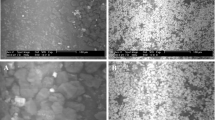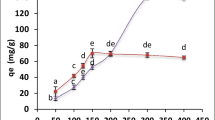Abstract
Biosorption of uranium from nuclear waste liquids and contaminated surface waters and soils has recently attracted special interest. However, the detailed mechanism of uranium uptake by plants is not well understood. The aim of this work is to investigate the role of cell wall components of the freshwater alga Chara fragilis in uranium sequestration from its solution. Three types of algae preparations: extract of cell wall polysaccharides, dried and live algae were subjected to uranium solutions of different concentration and pH. FTIR and X-ray diffraction were used to assess both potential binding sites and the form of the uranyl sequestered by algae. Sorption of uranium by live and dry algae shows remarkable differences both in terms of overall uptake and mechanisms involved. All experiments are consistent with the conclusion that coprecipitation of uranyl species with CaCO3 is the major binding mechanism in uranium sequestration by Chara fragilis, while the direct exchange of Ca2+ with UO22+ has a minor role. Live algae are twice as efficient in sequestering uranium from solution than dried ones due to the formation of different crystalline forms such as aragonite and rutherfordine forming in live algae in the presence of the uranyl species in solution. It therefore appears that metabolic processes such as photosynthesis, most likely through the regulation of pH, play a key role in the uranium uptake by plants. Further understanding of the complex mechanism of metabolic control of the uranium uptake by plants is needed before the planning of bioremediation of this element.









Similar content being viewed by others
References
Aleissa KA, Shabana E-SI, Al-Masoud FIS (2004) Accumulation of uranium by filamentous green algae under natural environmental conditions. J Radioanal Nucl Ch 260:683–687
Andersen RA (ed) (2005) Algal culturing techniques. Elsevier Inc., Amsterdam
Berestovsky GN, Ternovsky VI, Kataev AA (2001) Through pore diameter in the cell wall of Chara Corallina. J Exp Bot 52:1173–1177
Bhainsa KC, D’Souza SF (1999) Biosorption of uranium (VI) by Aspergillus fumigatus. Biotechnol Tech 13:695–699
Carpita N (2007) Cell wall–ion interactions: significance for the nutrition of plants and their stress tolerance. In: Satellmacher B, Horst WJ (eds) The appoplast of higher plants: compartment of storage. Transport and Reactions Springer, Netherlands, pp 15–18
Chernorukov NG, Knyazev AV, Knyazeva MA, Sergacheva IV (2002) Synthesis, structure, and physicochemical characteristics of rutherfordine and tetrasodium uranyl tricarbonate. Radiochemistry 44:212–215
Davis TA, LLanes F, Volesky B, Mucci A (2003a) Metal selectivity of Sargassum spp. and their Alginates in relation to their r-l-guluronic acid content and conformation. Environ Sci Technol 37:261–267
Davis TA, Volesky B, Mucci A (2003b) A review of the biochemistry of heavy metal biosorption by brown algae. Water Res 37:4311–4330
Dean JA (1999) Lange’s handbook of chemistry, 15 edn. McGrow-Hill, New York
Dubinsky Z, Rotem J (1974) Relations between algal populations and the pH of their media. Oecologia 16:53–60
Dushenkov S, Vasudev D, Kapulnik Y, Gleba D, Fleisher D, Ting KC, Ensley B (1997) Removal of uranium from water using terrestrial plants. Environ Sci Technol 31:3468–3474
Ebbs SD, Brady DJ, Kochian LV (1998) Role of uranium speciation in the uptake and translocation of uranium by plants. J Exp Bot 49:1183–1190
Goldberg EL, Grachev MA, Bobrov VA, Bessergenev AV, Zolotaryov BV, Likhoshway YV (1998) Do diatom algae frustules accumulate uranium? Nucl Instrum Meth A 405:584–589
Kalin M, Wheeler WN, Meinrath G (2005) The removal of uranium from mining waste water using algal/microbial biomass. J Environ Radioact 78:151–177
Khan MH, Warwick P, Evans N (2006) Spectrophotometric determination of uranium with arsenazo-III in perchloric acid. Chemosphere 63:1165–1169
Le Cloirec P, Guibal E, Saucedo I, Jansson-Charrier M (1995) Approach of uranium sorption mechanisms on chitosan and glutamate glucan by IR and 13C-NMR analysis. React Funct Polym 27:209–221
Malekzadeh F, Latifi AM, Shahamat M, Levin M, Colwell RR (2002) Effects of selected physical and chemical parameters on uranium uptake by the bacterium Chryseomonas MGF-48. World J Microbiol Biotechnol 18:599–602
McConnaughey TA, Falk RH (1991) Calcium–proton exchange during algal calcification. Biol Bull 180:185–195
Nakamoto K (1997) Infrared and Raman spectra of inorganic and coordination compounds. Wiley, London
Popper ZA, Fry SC (2003) Primary cell wall composition of bryophytes and charophytes. Ann Bot 91:1–12
Rivas BL, Pereira E, Jara M, Esparza C (2006) Resins with the ability to bind copper and uranyl ions. J Appl Polym Sci 99:706–711
Russell AD, Emerson S, Nelson BK, Erez J, Lea DW (1993) Uranium in foraminiferal calcite as a recorder of seawater uranium concentrations. Geochim Cosmochim Acta 58:671–681
Schiewer S, Volesky B (1995) Modeling of the proton–metal ion exchange in biosorption. Environ Sci Technol 29:3049–3058
Vagenas NV, Gatsouli A, Kontoyannis CG (2003) Quantitative analysis of synthetic calcium carbonate polymorphs using FT-IR spectroscopy. Talanta 59:831–836
Vieira RHSF, Volesky B (2000) Biosorption: a solution to pollution? Int Microbiol 3:7–24
Vrabel J, Glynn PD (1998) User’s guide to PHRQCGRF-A computer program for graphical interpretation of PHREEQC geochemical transport simulations. Open-File Report 98-281 1-30. US Geological Survey
Yang J, Volesky B (1999a) Biosorption of uranium on Sargasum biomass. Water Res 33:3357–3363
Yang J, Volesky B (1999b) Cadmium biosorption rate in protonated Sargassum biomass. Environ Sci Technol 33:751–757
Acknowledgments
This work was supported by the grant no. 143016 from the Ministry of Science and Environmental Protection, Republic of Serbia.
Author information
Authors and Affiliations
Corresponding author
Additional information
Regional Biophysics Conference of the National Biophysical Societies of Austria, Croatia, Hungary, Italy, Serbia, and Slovenia.
Rights and permissions
About this article
Cite this article
Daković, M., Kovačević, M., Andjus, P.R. et al. On the mechanism of uranium binding to cell wall of Chara fragilis . Eur Biophys J 37, 1111–1117 (2008). https://doi.org/10.1007/s00249-008-0282-3
Received:
Revised:
Accepted:
Published:
Issue Date:
DOI: https://doi.org/10.1007/s00249-008-0282-3




